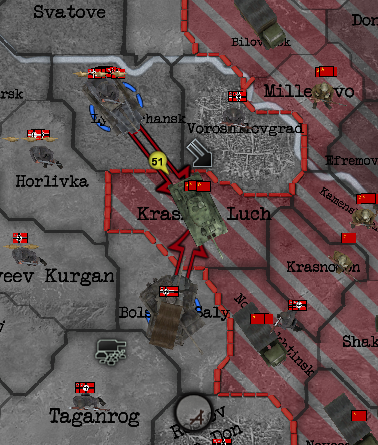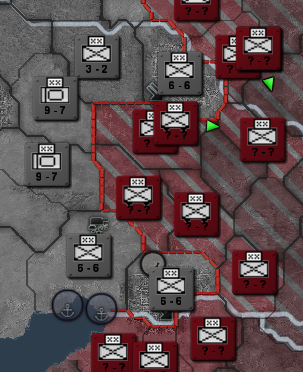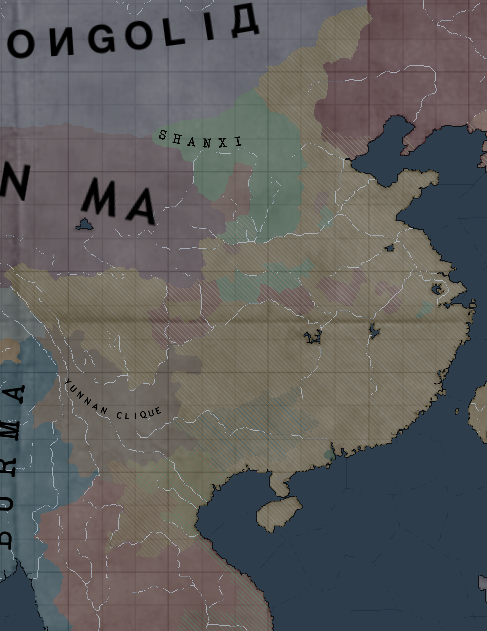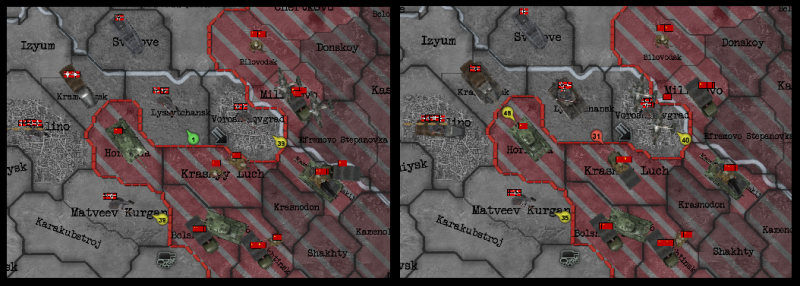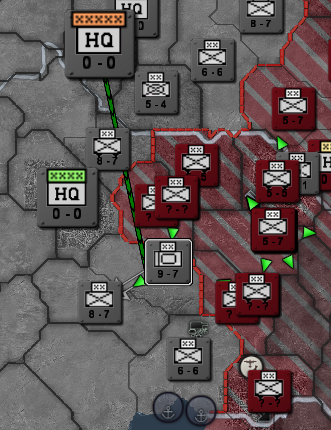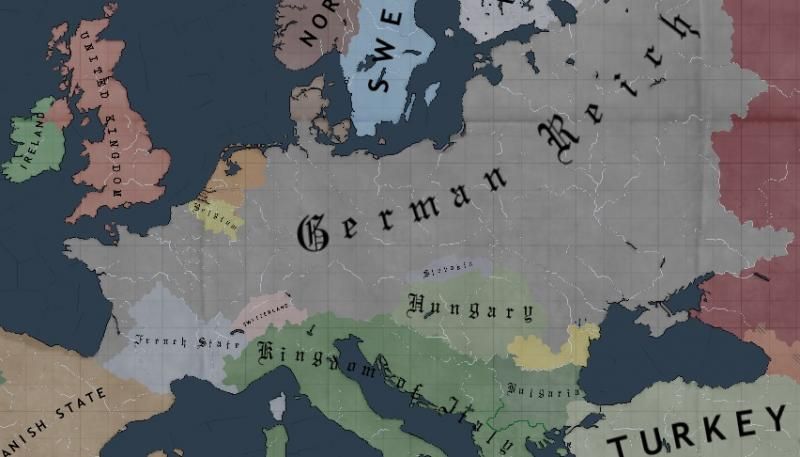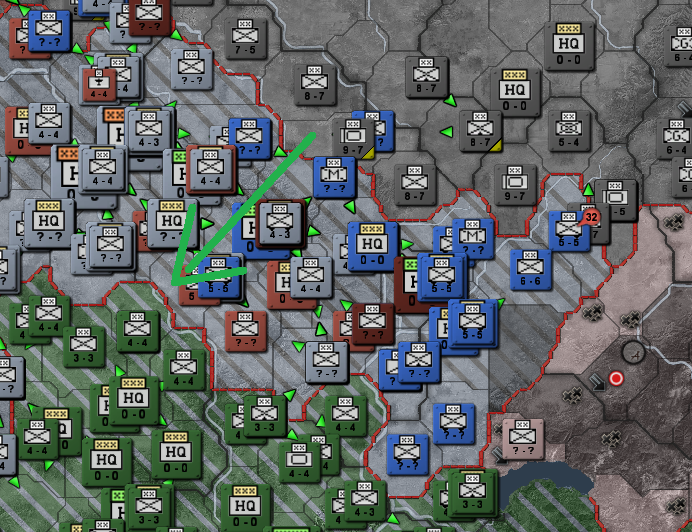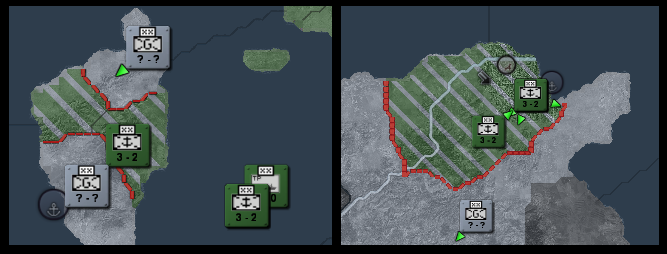The German Reich and the Second World War
- Thread starter enigmamcmxc
- Start date
-
We have updated our Community Code of Conduct. Please read through the new rules for the forum that are an integral part of Paradox Interactive’s User Agreement.
You are using an out of date browser. It may not display this or other websites correctly.
You should upgrade or use an alternative browser.
You should upgrade or use an alternative browser.
Extensive IC beyond the Urals, extensive manpower, two years to peacefully rebuild, and a massive army that I should have destroyed before seizing Moscow.
I have thus far, since the recent declaration of war, yet to encounter a Soviet militia unit, they are all infantry, motorized and armor.
I have thus far, since the recent declaration of war, yet to encounter a Soviet militia unit, they are all infantry, motorized and armor.
And your troops haven't received any significant equipment upgrades, like mot->mech or AT->TD/AssGun?
haha hell no! 
Since I thought the West was beaten, I was gearing everything around building a navy (where most of my research went) and expanding my airbases (were quite a bit of the IC went). On top of which, I spent the period of peace reinforcing my depleted units, expanding my U-Boat arm, and building an extensive infrastructure system in the east. The land arm was basically forgotten, although it was not like I had the IC to upgrade my horse drawn support brigades into motorized ones.
Since I thought the West was beaten, I was gearing everything around building a navy (where most of my research went) and expanding my airbases (were quite a bit of the IC went). On top of which, I spent the period of peace reinforcing my depleted units, expanding my U-Boat arm, and building an extensive infrastructure system in the east. The land arm was basically forgotten, although it was not like I had the IC to upgrade my horse drawn support brigades into motorized ones.
woooow, I can't believe it, your AAR is more interesting day by day... I do hope you get total victory, but things are really really interesting right now
I tell you one thing I really like about your AAR - it's real. You fight hard, and sometimes you win, other times you don't. So many AARs out there are either "Watch me steamroll!" (not interesting) or "Ooh I got steamrolled" (not educational). But this one is great, because it's so much more realistic - I can learn from this, your techniques and strategies, but you still don't win every time. It's more encouraging to me, a novice HOI3 player, and I'm learning a lot more.
Keep up the good work!
Keep up the good work!
I love this AAR. Like others have echoed, and like MiltonS said, I love how dynamic it is, how there is always something exciting happening. And the presentation is fantastic, a wonderful blend of text and images.
Just wonderful all over. Thank you for putting so much time into this.
Just wonderful all over. Thank you for putting so much time into this.
Battle of the Voroshilovgrad - Rostov line (2 October – 4 November)
Following the withdrawal from the Don River bend, Army Group South had attempted to establish a new frontline from Voroshilovgrad to Rostov-on-Don. However, the Red Army had been hot on the heels of our withdrawing forces and had captured Krasnyi Luch before our troops could move into the area. As a result, composite battle groups of the 4th and 6th SS Panzer Armies were ordered to attack this bulge from the north and south.
On 2 October, eleven divisions struck aiming to pinch off the forward Soviet troops, destroy the bulge, and straighten out the frontline. As the panzers, halftracks, and trucks moved forward, the Red Army counterattacked. Soviet motorized forces struck the southern wing of our attack, and fed armoured formations into Krasnyi Luch to counter our northern blow. The attack on our southern wing dwindled our offensive strength down from eleven divisions to seven. In support, the Red Air Force was launching daily high and low level bombing raids on our attacking and defending troops. The Luftwaffe squadrons, already based on the Eastern Front, were unable to reply due to the heavy losses previously received, thus the decision was made to temporarily transfer forces from the Western Front. 320 FW 190s and 640 ME 410s were dispatched until the offensive began in the west. By 7 October, the battle group assaulting the northern wing of Krasnyi Luch had dropped to three divisions, and the next day the attack was finally called off. While the attack had mauled four Red Army divisions, due to the dense air cover there had been no break through.
On 9 October, intercepted radio communications suggested that the Red Army was withdrawing all forces from Krasnyi Luch: news that would have been much more welcomed in the previous days, although there was no troops to take advantage. The following day, the Red Army finally captured the small town of Bolshiye Sal (north of Rostov and south of Krasnyi Luch). With the Soviets in control of these two areas, and the vast open terrain in between, Rostov was now looking rather isolated and the Red Army in a commanding position to push west. However, the heavy fighting that had taken place during the withdrawal from the Don River bend and for these two small towns had seemed to sap the offensive power of the Red Army.
For four days peace descended across the front, it seemed the Red Army had been rendered ineffective by the fighting. This was not the case. The Red Army has simply been redeploying their troops. On 14 October, hundreds of Soviet tanks rolled across the open Steppe and farmland towards the Ukrainian city of Horlivka. Facing this onslaught was the 13th Panzer Division. For a day and a half a rolling armour battle unfolded in the countryside in front of the city. Despite their best efforts, and the destruction of scores of Soviet tanks, the 13th Panzer Division was forced to withdraw creating a hole in the frontline, and leaving the city in Soviet hands. A rapidly assembled battle group of infantry and tanks were thrown into the flank of the overstretched and weakened Red Army troopers. This attack stopped the Red Army from achieving the breakthrough that they sought, closed the gap, but was unable to retake the city. A complete break of the front had narrowly been avoided. Meanwhile, to their northeast, reconnaissance forces had identified only a small force holding the area around Krasnyi Luch. The 16th SS Panzergrendier and the 22nd and 27th Panzer Divisions were ordered forward to smash this Red Army formation. On the 16th, the area was retaken. However, this double victory was overshadowed by international developments.
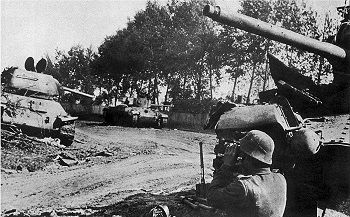
A soldier from the 13th Panzer Division looks towards no-mans-land,
surrounded by knocked out Soviet tanks.
On the 16th, the Japanese Empire announced to the world that they had defeated China and annexed its territory in the name of the Emperor. Their next move, they declared, was to remove all European imperialists from Asia and create an Asian only "Co-Prosperity Sphere". The collapse of Chinese resistance sent a shockwave around the world: the Chinese had only recently – with the help of the Soviets – destroyed the Kwantung Army and launched two invasions of Japan. It was also believed that the British Empire – known to have sent numerous divisions from all over the empire – had suffered massive losses during the Japanese offensive. A short time after the Japanese announcement, international newspapers made front page news of the US marine landing on Taiwan.
Over the course of the next week, the Red Army launched numerous limited attacks all along our line. Each struck at a different point, slowly withering down the ability of our armed forces to resist. The first struck Voroshilovgrad and Krasnyi Luch. After two days, our troops once again were forced to give up the latter and the Soviets halted their attack on Voroshilovgrad. Next, an amphibious attack was launched against Taganrog. As this attack was fought off, the Red Army launched a major offensive across the entire sector on the 25th. That day, Voroshilovgrad, Lysychansk, and Matveev Kurgan were all struck by Red Army infantry and tanks. Our own infantry, and especially the Panzer Group, were exhausted from the constant fighting, which had worn down their ability to fend off prolonged attacks. With the frontline commanders noting that their men could not hold out for more than a few days, the front looked destined to crack. At this point, the Panzer Group launched a final hurrah of the campaign in an attempt to force the Red Army to halt their attacks. The Red Army effort against Lysychansk was halted, and then the 2nd SS, 3rd SS, and 5th SS struck out towards Krasnyi Luch while the 22nd Panzer and 104th and 109th Motorized divisions attacked Horlivka.
These attacks, while initially successful and nearly achieving their goals, were ultimately failures. The Red Army simply had just too many troops in the area. On the 30th, the Red Army marched into Voroshilovgrad while their attack at Matveev Kurgan had barely been fended off. The same day, on the Western Front, the U-Boat fleet was ordered back to port after heavy losses and numerous more damaged within the space of a few days.
With Voroshilovgrad lost, Lysychansk was abandoned. This formed a major bulge in the frontline and left Rostov looking even more vulnerable. The city’s strategic importance, being the southern anchor of the frontline, had been lost. It was now decided to abandon the city and redeploy the city’s garrison behind Matveev Kurgan – under constant and repeated attacks – before the Soviets broke though. The previous month of fighting appeared as a grand repeat of the fighting that took place around the city during 1945. Here in the present, Rostov’s surrounding area lay waste, littered with foxholes, craters, bodies, burnt out tanks, and other assorted wrecked military equipment from both sides. Yet not a single shot had been fired in either defense of the city or an attempt to take it, but Rostov had still fallen. On 4 November, the Red Army finally punched through our lines at Matveev Kurgan, several hours after the Rostov garrison had moved in behind the frontline and proceeded to dig in.
25,000 men had been killed in the fighting, and once more a similar number of Red Army troopers had been lost. However, the Soviet attempt to break our line had failed. On the other hand, the offensive and defensive power of the Panzer Group – and the infantry of Army Group South in this area – had been seriously weakened. The only major positive coming out of this entire affair was the destruction of 120 Red Air Force bombers and 50 fighters for the mere loss of 11 of our own.
Following the withdrawal from the Don River bend, Army Group South had attempted to establish a new frontline from Voroshilovgrad to Rostov-on-Don. However, the Red Army had been hot on the heels of our withdrawing forces and had captured Krasnyi Luch before our troops could move into the area. As a result, composite battle groups of the 4th and 6th SS Panzer Armies were ordered to attack this bulge from the north and south.
On 2 October, eleven divisions struck aiming to pinch off the forward Soviet troops, destroy the bulge, and straighten out the frontline. As the panzers, halftracks, and trucks moved forward, the Red Army counterattacked. Soviet motorized forces struck the southern wing of our attack, and fed armoured formations into Krasnyi Luch to counter our northern blow. The attack on our southern wing dwindled our offensive strength down from eleven divisions to seven. In support, the Red Air Force was launching daily high and low level bombing raids on our attacking and defending troops. The Luftwaffe squadrons, already based on the Eastern Front, were unable to reply due to the heavy losses previously received, thus the decision was made to temporarily transfer forces from the Western Front. 320 FW 190s and 640 ME 410s were dispatched until the offensive began in the west. By 7 October, the battle group assaulting the northern wing of Krasnyi Luch had dropped to three divisions, and the next day the attack was finally called off. While the attack had mauled four Red Army divisions, due to the dense air cover there had been no break through.
On 9 October, intercepted radio communications suggested that the Red Army was withdrawing all forces from Krasnyi Luch: news that would have been much more welcomed in the previous days, although there was no troops to take advantage. The following day, the Red Army finally captured the small town of Bolshiye Sal (north of Rostov and south of Krasnyi Luch). With the Soviets in control of these two areas, and the vast open terrain in between, Rostov was now looking rather isolated and the Red Army in a commanding position to push west. However, the heavy fighting that had taken place during the withdrawal from the Don River bend and for these two small towns had seemed to sap the offensive power of the Red Army.
For four days peace descended across the front, it seemed the Red Army had been rendered ineffective by the fighting. This was not the case. The Red Army has simply been redeploying their troops. On 14 October, hundreds of Soviet tanks rolled across the open Steppe and farmland towards the Ukrainian city of Horlivka. Facing this onslaught was the 13th Panzer Division. For a day and a half a rolling armour battle unfolded in the countryside in front of the city. Despite their best efforts, and the destruction of scores of Soviet tanks, the 13th Panzer Division was forced to withdraw creating a hole in the frontline, and leaving the city in Soviet hands. A rapidly assembled battle group of infantry and tanks were thrown into the flank of the overstretched and weakened Red Army troopers. This attack stopped the Red Army from achieving the breakthrough that they sought, closed the gap, but was unable to retake the city. A complete break of the front had narrowly been avoided. Meanwhile, to their northeast, reconnaissance forces had identified only a small force holding the area around Krasnyi Luch. The 16th SS Panzergrendier and the 22nd and 27th Panzer Divisions were ordered forward to smash this Red Army formation. On the 16th, the area was retaken. However, this double victory was overshadowed by international developments.

A soldier from the 13th Panzer Division looks towards no-mans-land,
surrounded by knocked out Soviet tanks.
On the 16th, the Japanese Empire announced to the world that they had defeated China and annexed its territory in the name of the Emperor. Their next move, they declared, was to remove all European imperialists from Asia and create an Asian only "Co-Prosperity Sphere". The collapse of Chinese resistance sent a shockwave around the world: the Chinese had only recently – with the help of the Soviets – destroyed the Kwantung Army and launched two invasions of Japan. It was also believed that the British Empire – known to have sent numerous divisions from all over the empire – had suffered massive losses during the Japanese offensive. A short time after the Japanese announcement, international newspapers made front page news of the US marine landing on Taiwan.
Over the course of the next week, the Red Army launched numerous limited attacks all along our line. Each struck at a different point, slowly withering down the ability of our armed forces to resist. The first struck Voroshilovgrad and Krasnyi Luch. After two days, our troops once again were forced to give up the latter and the Soviets halted their attack on Voroshilovgrad. Next, an amphibious attack was launched against Taganrog. As this attack was fought off, the Red Army launched a major offensive across the entire sector on the 25th. That day, Voroshilovgrad, Lysychansk, and Matveev Kurgan were all struck by Red Army infantry and tanks. Our own infantry, and especially the Panzer Group, were exhausted from the constant fighting, which had worn down their ability to fend off prolonged attacks. With the frontline commanders noting that their men could not hold out for more than a few days, the front looked destined to crack. At this point, the Panzer Group launched a final hurrah of the campaign in an attempt to force the Red Army to halt their attacks. The Red Army effort against Lysychansk was halted, and then the 2nd SS, 3rd SS, and 5th SS struck out towards Krasnyi Luch while the 22nd Panzer and 104th and 109th Motorized divisions attacked Horlivka.
These attacks, while initially successful and nearly achieving their goals, were ultimately failures. The Red Army simply had just too many troops in the area. On the 30th, the Red Army marched into Voroshilovgrad while their attack at Matveev Kurgan had barely been fended off. The same day, on the Western Front, the U-Boat fleet was ordered back to port after heavy losses and numerous more damaged within the space of a few days.
With Voroshilovgrad lost, Lysychansk was abandoned. This formed a major bulge in the frontline and left Rostov looking even more vulnerable. The city’s strategic importance, being the southern anchor of the frontline, had been lost. It was now decided to abandon the city and redeploy the city’s garrison behind Matveev Kurgan – under constant and repeated attacks – before the Soviets broke though. The previous month of fighting appeared as a grand repeat of the fighting that took place around the city during 1945. Here in the present, Rostov’s surrounding area lay waste, littered with foxholes, craters, bodies, burnt out tanks, and other assorted wrecked military equipment from both sides. Yet not a single shot had been fired in either defense of the city or an attempt to take it, but Rostov had still fallen. On 4 November, the Red Army finally punched through our lines at Matveev Kurgan, several hours after the Rostov garrison had moved in behind the frontline and proceeded to dig in.
25,000 men had been killed in the fighting, and once more a similar number of Red Army troopers had been lost. However, the Soviet attempt to break our line had failed. On the other hand, the offensive and defensive power of the Panzer Group – and the infantry of Army Group South in this area – had been seriously weakened. The only major positive coming out of this entire affair was the destruction of 120 Red Air Force bombers and 50 fighters for the mere loss of 11 of our own.
This is a nail-biter! Part of me wants you to lose for the symmetry of it, but part of me wants to see you pull a win out of a dwindling situation. Either way, I already can't wait for the next part.
its difficult to stop an enemy who was only contained by static defences behind a river once it comes out into the planes. The best way I found was to give some troops time to dig in into the new position and have more strength there than will ultimately remain.
I'm still confident in total Victory, once you throw back those Angle-Saxons into the Nordsee
Thanks again everyone for the comments.
Thanks for the tips. I have enough infantry only to make such a move a few more times, then I will not have the troops to man the frontline. The border required every combat division to man. If I pull back behind the Dnieper and back to the various fortifications the Soviet AI built (a line roughly south from Leningrad to the Dnieper) then I should be able to free up an awful lot of troops (to allow for total victory perhaps? :happy: ). A bit drastic, but I think that is the move I will need to make soon.
its difficult to stop an enemy who was only contained by static defences behind a river once it comes out into the planes. The best way I found was to give some troops time to dig in into the new position and have more strength there than will ultimately remain.
Thanks for the tips. I have enough infantry only to make such a move a few more times, then I will not have the troops to man the frontline. The border required every combat division to man. If I pull back behind the Dnieper and back to the various fortifications the Soviet AI built (a line roughly south from Leningrad to the Dnieper) then I should be able to free up an awful lot of troops (to allow for total victory perhaps? :happy: ). A bit drastic, but I think that is the move I will need to make soon.
The shortest line is not always the best as the enemy then gets to concentrate his forces. And the shortes line is Berlin, with a level 10 Führerbunker in it 
The Italians and the Western Front (5 August – 15 November)
Since the French attack towards Italy in May and the Italian counteroffensive that followed, the Italians had been playing a major role on the Western Front. The Italians wished to seize southern France, as they had planned to do so in 1940, and annex it as part of their Empire. However, the Italian army had stalled in front of Toulouse: the new French capital, rapidly fortified, following the fall of Vichy. While their offensive may have stalled, they held a sizeable piece of territory and had deployed over one million soldiers (the bulk of their army) onto the front. They may not be able to advance forward, but the Allies were incapable of pushing them back.
As our own forces fought off the last of the American assaults to push towards the West Wall and plans were put in motion to transfer forces from the east, Field Marshal Friedrich Paulus began planning for an offensive to inflict a major defeat upon the Americans. Having seen the loss of 40,000 men and countless tanks and vehicles attempting to reach ambitious objectives over one hundred miles away in territory manned by overwhelming Allied numbers, Paulus opted for a more limited attack. Local superiority in men and equipment would be used to advance the 40 miles, or so, to link up with the Italians at the shortest point between our two forces. Such a move would trap all American forces on the southern sector of the front. Our troops would then act as a hammer and smash the trapped Americans upon the anvil that would be the Italian line. Such a victory should severely reduce the available American forces, and provide the possibility of returning the balance of power back into Axis hands. Due to the Italians playing an important part in the plan, Paulus named his operation with a little flavor: Bello Gallico, after Caesar’s war commentary on his campaigns in Gaul.
In the meantime, while our forces were fighting in the Rostov area in the east, the Italians mounted two invasions in the west. The Italians had massive expanded the San Marco Regiment to the size of a reinforced Corps. On 30 August, two marine divisions landed on Corsica and quickly overrun the French garrison. This was followed by the Italian return to North Africa on 16 September. Again, the marines landed and routed the nearby French units. However, in France the situation was not as positive. With our own forces on the defensive and conducting no aggressive actions, the Allies had turned their attention towards the Italians.
Much fighting between Italian and Anglo-French forces took place around the northern edge of the Italian lines. The Americans added to this pressure assaulting various sections along the eastern sector. Eventually, in late October, having finally redeployed enough troops, the Americans launched a massive offensive. An estimated one third of the American troops in Europe were focused on a small section of the Italians line. The Italians were unable to withstand such an assault and their frontline rapidly collapsed. In just sixteen days, the Americans had reached the Mediterranean Sea, cutting off the Italian troops into two pockets and threatening the Italian homeland. Following behind the American spearheads was a substantial French presence, adding to the Italian problems.
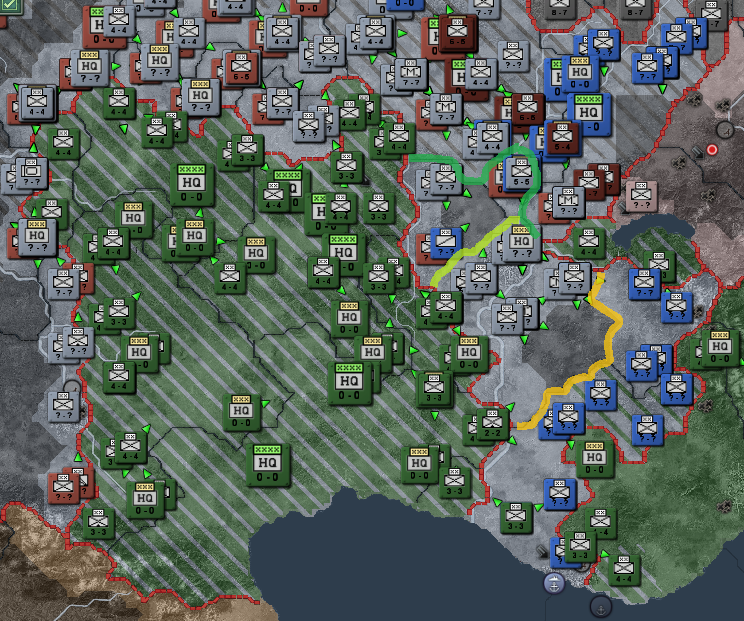
Green: the frontline in mid-August
Lime: the frontline on 1 November
Orange: the frontline on 9 November
Dotted Red: Present frontline, 15 November
Late on 15 November, the Italian Chief of Staff Pietro Badoglio flew to Berlin to provide an update on the Italian situation and to demand immediate German action. Badoglio reported that 820,000 Italian troops, the bulk of the Regio Esercito, were now trapped in France. Only 38 divisions (eight infantry, five marine, and 25 static, totaling 336,000 men) lay outside the pocket and available to defend Italy. However, most of these were on garrison duties and spread out across Italy, Corsica, North Africa, the Balkans and the Dodecanese. Badoglio demanded an immediate German offensive to relieve his formations and threatened if the Americans breached the Alps and entered the Po Valley – the location of Italy’s merger industrial base – that Italy would have to seek an armistice and peace conditions with the Allies.
As a consequence of this meeting, Field Marshal Kurt von Hammerstein-Equord, Chief of OKW, began drawing up plans for Case Lombard: the deployment/invasion of Italy if it sided with the Allies or was to be used as a base of operations by the Allies to invade Germany from the south. As for the strategic situation, the Field Marshal phoned OB West to speak with Paulus about the readiness of his forces. Paulus responded that his men were in place and that he could launch his offensive within 12-hours.
Since the French attack towards Italy in May and the Italian counteroffensive that followed, the Italians had been playing a major role on the Western Front. The Italians wished to seize southern France, as they had planned to do so in 1940, and annex it as part of their Empire. However, the Italian army had stalled in front of Toulouse: the new French capital, rapidly fortified, following the fall of Vichy. While their offensive may have stalled, they held a sizeable piece of territory and had deployed over one million soldiers (the bulk of their army) onto the front. They may not be able to advance forward, but the Allies were incapable of pushing them back.
As our own forces fought off the last of the American assaults to push towards the West Wall and plans were put in motion to transfer forces from the east, Field Marshal Friedrich Paulus began planning for an offensive to inflict a major defeat upon the Americans. Having seen the loss of 40,000 men and countless tanks and vehicles attempting to reach ambitious objectives over one hundred miles away in territory manned by overwhelming Allied numbers, Paulus opted for a more limited attack. Local superiority in men and equipment would be used to advance the 40 miles, or so, to link up with the Italians at the shortest point between our two forces. Such a move would trap all American forces on the southern sector of the front. Our troops would then act as a hammer and smash the trapped Americans upon the anvil that would be the Italian line. Such a victory should severely reduce the available American forces, and provide the possibility of returning the balance of power back into Axis hands. Due to the Italians playing an important part in the plan, Paulus named his operation with a little flavor: Bello Gallico, after Caesar’s war commentary on his campaigns in Gaul.
In the meantime, while our forces were fighting in the Rostov area in the east, the Italians mounted two invasions in the west. The Italians had massive expanded the San Marco Regiment to the size of a reinforced Corps. On 30 August, two marine divisions landed on Corsica and quickly overrun the French garrison. This was followed by the Italian return to North Africa on 16 September. Again, the marines landed and routed the nearby French units. However, in France the situation was not as positive. With our own forces on the defensive and conducting no aggressive actions, the Allies had turned their attention towards the Italians.
Much fighting between Italian and Anglo-French forces took place around the northern edge of the Italian lines. The Americans added to this pressure assaulting various sections along the eastern sector. Eventually, in late October, having finally redeployed enough troops, the Americans launched a massive offensive. An estimated one third of the American troops in Europe were focused on a small section of the Italians line. The Italians were unable to withstand such an assault and their frontline rapidly collapsed. In just sixteen days, the Americans had reached the Mediterranean Sea, cutting off the Italian troops into two pockets and threatening the Italian homeland. Following behind the American spearheads was a substantial French presence, adding to the Italian problems.

Green: the frontline in mid-August
Lime: the frontline on 1 November
Orange: the frontline on 9 November
Dotted Red: Present frontline, 15 November
Late on 15 November, the Italian Chief of Staff Pietro Badoglio flew to Berlin to provide an update on the Italian situation and to demand immediate German action. Badoglio reported that 820,000 Italian troops, the bulk of the Regio Esercito, were now trapped in France. Only 38 divisions (eight infantry, five marine, and 25 static, totaling 336,000 men) lay outside the pocket and available to defend Italy. However, most of these were on garrison duties and spread out across Italy, Corsica, North Africa, the Balkans and the Dodecanese. Badoglio demanded an immediate German offensive to relieve his formations and threatened if the Americans breached the Alps and entered the Po Valley – the location of Italy’s merger industrial base – that Italy would have to seek an armistice and peace conditions with the Allies.
As a consequence of this meeting, Field Marshal Kurt von Hammerstein-Equord, Chief of OKW, began drawing up plans for Case Lombard: the deployment/invasion of Italy if it sided with the Allies or was to be used as a base of operations by the Allies to invade Germany from the south. As for the strategic situation, the Field Marshal phoned OB West to speak with Paulus about the readiness of his forces. Paulus responded that his men were in place and that he could launch his offensive within 12-hours.
Last edited:
Wut?:mellow: I don't think I have one :mellow:
Anyway the Italians need a breakthrough to their surrounded units immediately and a bit of a line backer in Italy itself.


